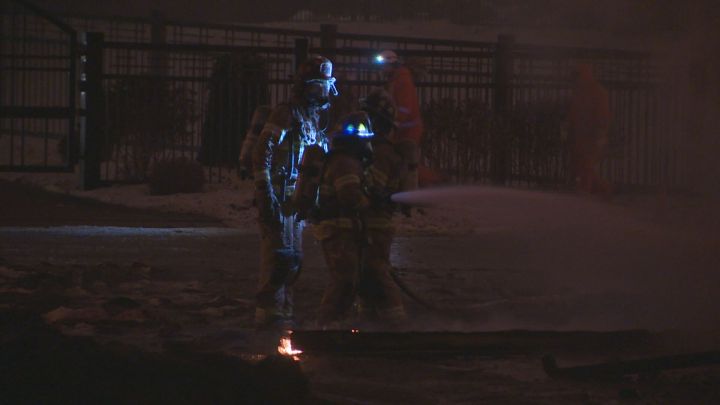The city of Edmonton continued to contend with cripplingly cold temperatures on Thursday, with Environment Canada forecasting it could feel as cold as -43 C when factoring in the wind chill overnight.

With the wicked weather not expected to let up until the new year, some of the city’s first responders are speaking out about the impact the deep freeze is having on their staff and how the public can stay safe.
“Obviously this is a very busy time for Fire Rescue Services,” Dave Matwichuk, deputy chief with Edmonton Fire Rescue Services, told Global News on Thursday.
“In extreme cold weather like this, we experience a lot of issues that hamper our ability to do a good job.”
Watch below: The deep freeze Edmontonians are currently contending with is presenting challenges for first responders in the city as well.

Matwichuk said the weather is tough on firefighters because most of the equipment they work with is metal and when it begins to freeze up, it sometimes doesn’t function properly. He said even the personal protection equipment worn by firefighters, like their self-contained breathing apparatuses, is prone to freezing up from moisture. He noted that working so constantly with water is not easy in extreme cold.
READ MORE: Cold temperatures sticking around Edmonton for remainder of week
Watch below: Global meteorologist Jesse Beyer’s weather forecast for Edmonton and surrounding areas on Thursday, Dec. 28, 2017.

He said the fire department has had to change out crews more often because of the cold.
“They’re closely monitored always, but even moreso on a basis where it’s extremely cold like this because of the decreased time of being able to work — whether it be a frostbite situation or extreme exhaustion.”
Tracy Buffalo, acting supervisor with Alberta Health Services in Edmonton, says frostbite is a major concern these days for both first responders and citizens.
“When it gets this cold out here, we want to really protect our face, our nose, our ears — that’s the first thing that’s going to get cold. Your skin can freeze in minutes.
READ MORE: Map: A look at how grossly cold it’s been across Canada

Get daily National news
Buffalo advised people to dress in layers and to wear gloves and cover exposed skin when outside and said in the event someone thinks they may have frostbite, they should “warm up gently” and not run hot water over the affected area.
As of 8:15 p.m. on Thursday, Edmonton was sitting at -25 C (feeling like -35 C with the wind chill) and both the city and surrounding areas remained under an extreme cold warning.
“A multi-day episode of very cold wind chills continues,” Environment Canada said on its website. “Another surge of cold arctic air into the province will maintain extreme cold conditions with wind chills of minus 40 to minus 50, tonight and through most of Friday. Conditions are expected to moderate Saturday.”
The weather agency said in addition to signs of frostbite and hypothermia, other symptoms of cold to watch for include shortness of breath, chest pain, muscle pain and weakness. Environment Canada also warned people not to keep their pets outside.
The Edmonton Police Service and some inner-city outreach organizations took to Twitter this week pleading with people to call 211 if people see someone in distress who appears to be needing shelter from the cold.
The City of Edmonton has said local shelters should be able to handle the increase in demand for most of the extremely cold nights this winter. However, as a last resort, the Central LRT station will open from 10 p.m. to 6 a.m. when temperatures drop to -20 C or below and local shelters are at 90 per cent capacity. The city has said the Churchill LRT station won’t be used this season due to ongoing construction.
READ MORE: Edmonton LRT station set to open as ‘last resort’ shelter from the cold
Watch below: On Dec. 24, 2017, Kim Smith filed this report about the City of Edmonton’s plans for ensuring no one is left without shelter during bitterly cold circumstances.

The Hope Mission also says there is an ongoing need for winter clothing for Edmontonians on the streets.
Buffalo said whether it’s dealing with people who have been exposed to the elements too long or other patients, the cold snap has had an impact on how paramedics do their jobs.
“For us, when it gets this cold, things like patient care outdoors, we don’t do much of. We do what we call a scoop and run: put them in the truck, get them warm. We may have to consider bystanders if they’re around, keeping them warm as well.”
Matwichuk said the fire department is also warning people about how they heat their homes during this bitterly cold stretch.
“Carbon monoxide, whether in a vehicle or a home, is something that should be closely monitored at all times,” he said. “In a vehicle, it’s nice to have a window slightly cracked open — if you’re idling in traffic as well. In the home, we always recommend a CO detector on every floor and one close to the bedroom.”
Matwichuk also suggested people should not leave vehicles idling in garages. In homes, he said one metre of space should be kept between furnaces or space heaters and anything else. To help furnaces work more efficiently, he said homeowners should ensure they change their furnace filters regularly.
Many Edmontonians have been having vehicle problems as a result of the extreme blast of winter. On Thursday night, the Alberta Motor Association said the wait time for a battery replacement or full tow in Alberta’s was 16 hours and 39 minutes, while the wait for a boost was five-and-a-half hours.
For a complete list of areas in Alberta that are under a weather warning or watch, click here.
Want your weather on the go? Download the Global News Skytracker weather app for IOS and Android.
-With files from Kim Smith








Comments